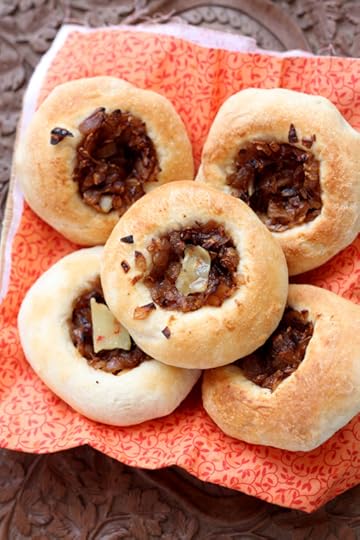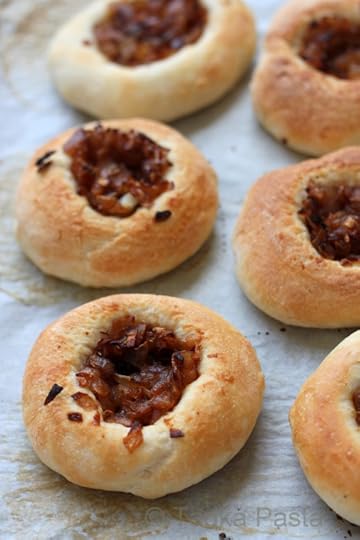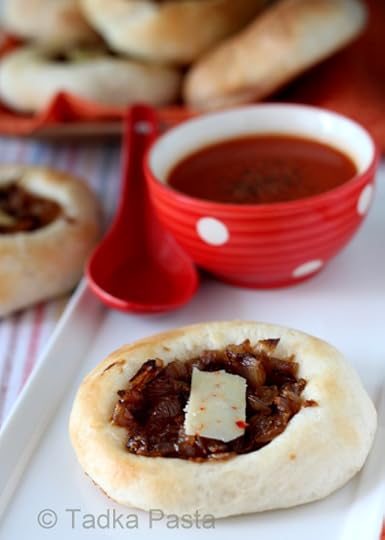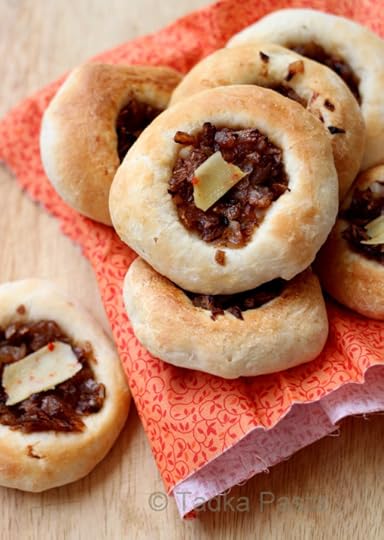Bring on the Bialys!
When we asked our pals and followers on Facebook to identify the round, chewy roll in the picture below, one comment read “Bialiies, & they are heaven. Full-sized ones from traditional Jewish baker are about four inches across by half an inch high at the edge, with an onion-poppy seed mixture not too dense so the onions caramelize as the bialiies bake. A very light dusting of flour after the topping is put keeps the onions moist as they caramelize.” You’re absolutely right, Heather, and we couldn’t have put it better.
Our bialys, part of this month’s baking assignment from the group We knead to bake, were topped a mite over-generously with caramelised onions than is traditional, but then we love our onions! We retarded the dough overnight – that is, we slowed down the fermentation process by refrigerating it. This improves the flavours in the final product and in this case also helped us achieve the classic Bialy chewiness that usually comes from using a strong or high gluten flour.
Bialys
Makes 8
For the Dough:
1 Teaspoon active dry yeast
1 Tablespoon sugar
1 to 1¼ cup warm water
3 cups all-purpose flour (If you have some vital wheat gluten, remove 3 tablespoons of the flour and replace it with the gluten)
1.5 Teaspoons salt
Milk for brushing the dough
For the Onion Filling
1 Tablespoon oil
3 medium onions, finely chopped
Salt and pepper to taste
Cheese to top the Bailys, optional
To make the dough – Put the yeast, sugar and warm water in a large bowl. Stir and set aside for 5 minutes. Add the flour and salt. Stir until the dough comes together as a mass and then cover and allow to rest for 10 minutes. This will help the dough absorb water and make it easier to knead. Knead again, adding a little more water or flour (not too much) if you need it, until your dough is smooth and elastic but not sticky.
Shape it into a ball and put it in a well-oiled bowl, coating the dough with oil on all sides. Cover and let it rise till about double. If you’re not making the Bialys right away, you can refrigerate the dough overnight at this point. When ready to make them, keep the dough at room temperature for about half an hour and then proceed with the rest of the recipe.
To make make the filling - Heat the oil in a pan, add the onions, and sauté over low to medium heat. Sprinkle a little salt and continue sautéing until they become soft and turn golden brown in colour. Add the pepper and set aside to cool.
To shape the Bialys - Sprinkle your work surface lightly with flour and place the dough on it. Divide it into 8 equal pieces and shape each one into a roll by flattening it and then pinching the ends together to form a smooth ball. Roll the ball to smooth the surface and then place the rolls on a lightly greased baking sheet and cover them with a kitchen towel. Let them rise for about one hour (about 1 1/2 to 2 hours for refrigerated dough) till pressing with a finger on the top leaves a dent.
Work on one piece at a time, keeping the others covered so they don’t dry out. Use your fingers, form the depression in the middle. Pinch the dough between your thumb and fingers, rotating as you go and gradually making the depression wider without actually poking a hole through.Remember not to press on the edges, or they will flatten out. Once shaped, you should have a depression about 3” in diameter with 1” of puffy dough around the edge, so your Bialy should be about 4” in diameter. Dock the centre of the Bialy with a fork so the centre doesn’t rise when baking. Also use a pair of scissors to make a cut at the bottom. Place the shaped bialys on a parchment lined (or greased) baking tray leaving about 2 inches space between them. Place the caramelised onion filling in the depressions of each Bialy. Brush the outer dough circle with milk. If the sides have collapsed too much alow the bialys to rise for 5-10 minutes before baking.
Bake the Bialys at 230C (450F) for about 15 minutes till they’re golden brown in colour. Put a little cheese in the centre of each roll if you like. Transfer them to a rack. Serve hot and fresh from the oven or at room temperature.
Adapted from King Arthur Flour









